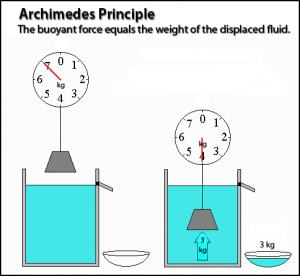Back to: PHYSICS SS1
Welcome to class!
In today’s class, we will be talking about upthrust (buoyancy). Enjoy the class!
Upthrust (Buoyancy)

When an object is immersed in the fluid, an upward force is applied to it. That upward force is known as the buoyant force.
It refers to the power of liquid to make the object float partially or completely on the surface of the water.
This phenomenon of upward force is known as Buoyancy.
Example- when a cork is immersed in the fluid, it comes to its surface.
The difference between the upward and downward forces acting on the bottom and the top of the cube, respectively, is called buoyancy.

Types of buoyancy
- Positive buoyancy
- Negative buoyancy
- Neutral buoyancy
Positive buoyancy:
It occurs when an object is lighter than the fluid it displaces.
The object will float because the buoyant force is greater than the object’s weight.
Example: A swimmer experiences a great amount of buoyant force. Israel’s Dead Sea is famous for attracting floating tourists. Saltwater is more-dense than freshwater and provides the more buoyant force. Buoyant and net forces are not the same. An object’s volume and density determine its buoyancy.
Negative buoyancy:
Negative buoyancy occurs when an object is denser than the fluid it displaces.
The object will sink because its weight is greater than the buoyant force.
Example: A submarine is designed to operate underwater by storing and releasing water through ballast tanks. If the command is given to descend, the tanks take in water and increase the vessel’s density.
Neutral buoyancy:
Neutral buoyancy occurs when an object’s weight is equal to the fluid it displaces.
Example: A scuba diver is trained in techniques to regulate buoyancy underwater. Swimming horizontally and taking deep, long breaths allow the diver to propel forward, not upward. Fish control buoyancy through an internal swim bladder. Similar to a submarine, the bladder is filled with gas as a means of altering buoyancy.

A Floating Balloon
Buoyancy determines the ease of a floating balloon. Hydrogen, helium and hot air are the ideal gases for balloon aviation. Unlike liquids and solids, gas molecules are spread farther apart. This empty space increases volume and decreases density. Astronomers use unmanned hot air balloons to gather clear pictures of the cosmos.
Hot air balloons rise into the air because the density of the air (warmer air) inside the balloon is less dense than the air outside the balloon (cooler air). The balloon and the basket displace a fluid that is heavier than the balloon and the basket, so it has a buoyant force acting on the system. Balloons tend to fly better in the morning when the surrounding air is cool.

Factors on which the buoyancy depends on
- The volume of the body submerged in the fluid.
- The density of the fluid in which the body is immersed.
Causes of buoyancy
When the fluid is at rest, there is a perpendicular force exerts on the surface. That force is a pressure which is exerted due to the molecules colliding with their surroundings. The pressure at all point in all direction in the fluid is the same.
Effects of buoyancy on different bodies of different weighs
There are 3 cases-
Weight is represented by “W”, it is acting vertically downwards.
Force of Buoyancy is represented by “U” it is acting vertically upward through the centre of gravity.
(1) W<U
In such a case, the body floats. The weight of the liquid displaced by an immersed object is equal to the weight of the body.
(2) W>U
In such a case, the body sinks. Here density of a body is greater than a fluid.
(3) W=U
In such a case, the body is fully immersed in the fluid. The apparent weight of the body and resultant force is zero.
Archimedes principle
It states that a body immersed in a fluid is buoyed up by a force equal to the weight of the displaced fluid. It applies to both floating and submerged bodies and to all fluids, i.e., liquids and gases.
It is discovered by the ancient Greek mathematician and inventor Archimedes.

In determining whether a given body will float in a given fluid:
- If the body is less dense than the fluid, it will float or, in the case of a balloon, it will rise.
- If the body is denser than the fluid, it will sink.
- If the body is two thirds as dense as the fluid, then two-thirds of its volume will be submerged displacing in the process a volume of fluid whose weight is equal to the entire weight of the body.
In our next class, we will be talking about Density and Relative Density. We hope you enjoyed the class.
Should you have any further question, feel free to ask in the comment section below and trust us to respond as soon as possible.


don’t really understand the archimede